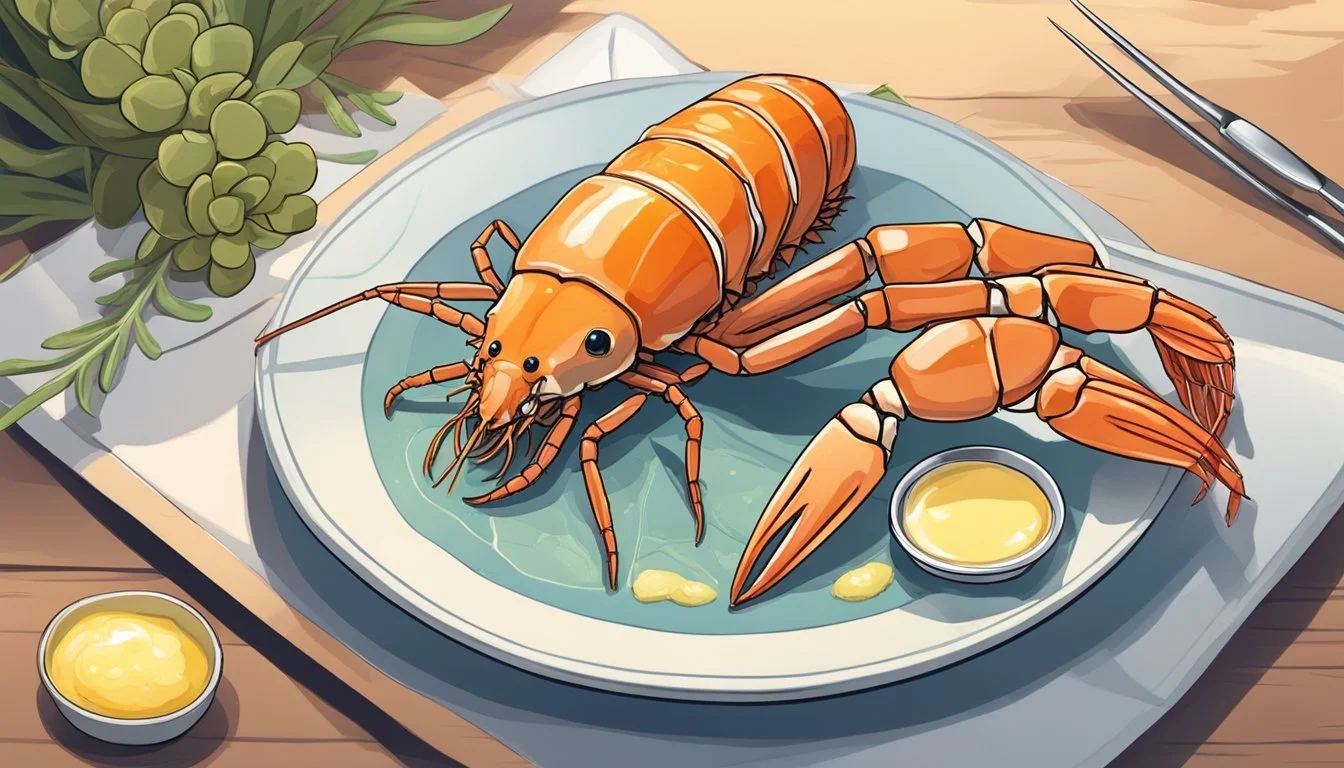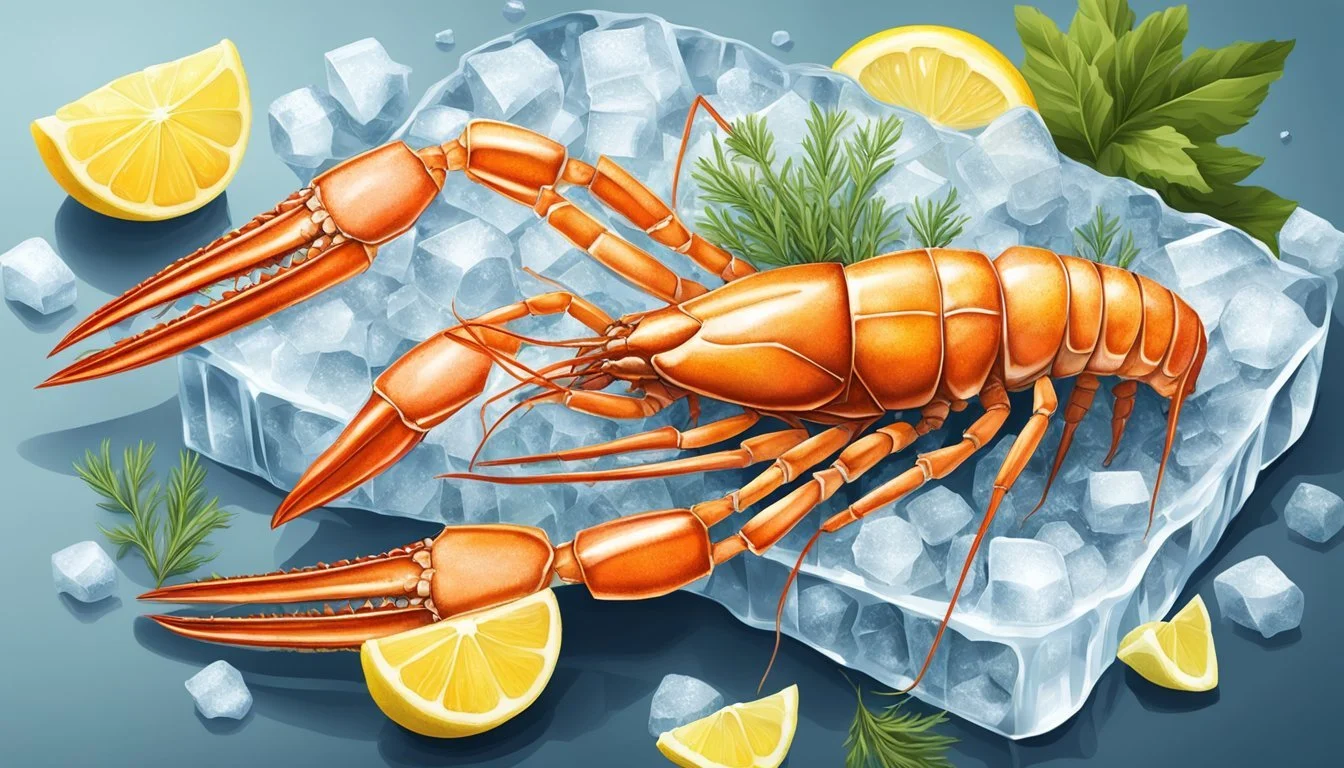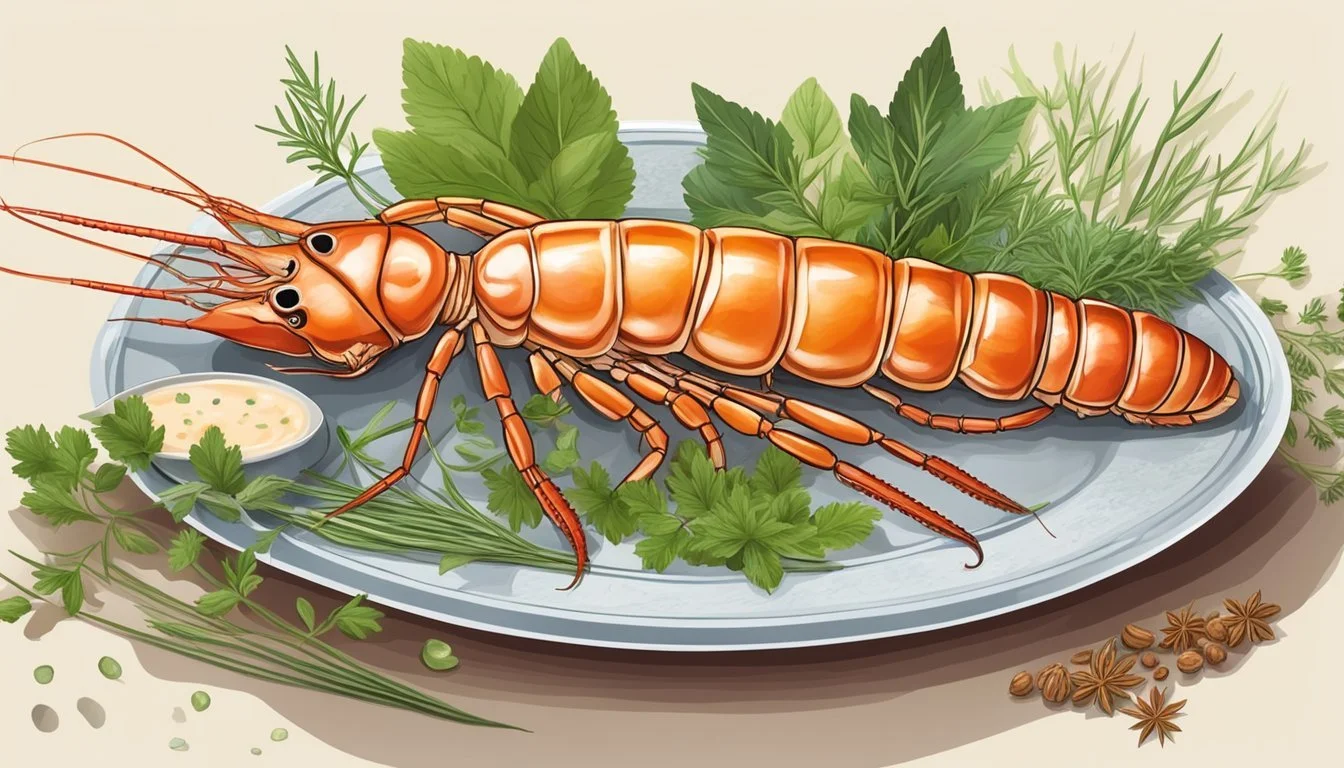How Do You Eat a Langoustine?
A Step-by-Step Guide
Langoustines, also known as Norway lobsters (What wine goes well with lobster?), Dublin Bay prawns, scampi, or scientifically as Nephrops norvegicus, are a prized type of shellfish (What wine goes well with shellfish?) found in the cold waters of the northeastern Atlantic and parts of the Mediterranean Sea. These small, sweet crustaceans are often compared to lobsters for their similar flavor profile and texture but come in a much smaller size. As a culinary delicacy, langoustines are savored for their delicate meat, particularly found in the tail section, and are a staple in gourmet cooking across various cuisines.
The process of eating langoustines may seem daunting at first due to their hard shell and small size. However, when approached correctly, diners can access the succulent meat, which is the highlight of the experience. Traditionally served whole, either boiled or grilled, they are often presented with the shell on, requiring a bit of skill to extract the meat. Expertise in handling these shellfish ensures that none of the flavorful flesh is wasted, offering the full gastronomic pleasure they are known for.
Eating langoustines involves a series of steps. One must first remove the head and peel away the shell to reveal the meat beneath. The tail meat, recognized for its rich and subtle sweetness, is typically accessed by pinching the end of the tail and gently pulling out the flesh. This extraction technique allows diners to appreciate the langoustine in its entirety, ensuring that each bite is as enjoyable as the culinary experts intend. With the proper approach, langoustines make for a sophisticated and delicious seafood experience.
Understanding Langoustines
Langoustines are a prized shellfish known for their delicate flavour and high nutritional value. They are a type of crustacean closely related to lobsters and crabs (how long does crab last?) and are a popular choice in gourmet cooking.
Biological Classification
Langoustines are scientifically referred to as Nephrops norvegicus and belong to the family Nephropidae. They are also commonly known as Norway lobsters, Dublin Bay prawns, or scampi. These crustaceans are distinguished by their slender bodies, orange-pink shell, and long, thin claws.
Habitat and Distribution
They primarily inhabit the northeastern Atlantic Ocean and can be found along the coasts stretching from the North Sea to the Aegean Sea. Langoustines prefer muddy bottoms of the ocean, where they create burrows. They are generally located at depths ranging from 20 to 800 meters, demonstrating their ability to adapt to various marine environments.
Nutritional Profile
Langoustines are revered not only for their taste but also for their nutritional content. They are a low-calorie source of protein, providing essential amino acids without a high fat content. A typical serving size of langoustines contains the following nutrients:
Nutrient Amount per 100g Calories 90 kcal Protein 19 g Phosphorus Ample Zinc Present Copper Present
The nutritional profile of langoustines makes them beneficial for maintaining strong bones, as well as contributing to overall health with their rich mineral content, including significant amounts of phosphorus, zinc, and copper.
Preparation Basics
Before indulging in the delicate flavor of langoustines, one must prepare them properly. The process involves defrosting if they are frozen, followed by cleaning and deveining to ensure the best culinary experience.
Defrosting Frozen Langoustines
To defrost frozen langoustines, it's recommended to wrap them in foil and place them in the refrigerator for approximately 12 to 14 hours. A slow defrost helps maintain the texture and flavor integrity of the langoustines. Once fully defrosted, rinse thoroughly. To expedite drying, pat them gently with a paper towel.
Cleaning and Deveining
The cleaning process starts with removing the head and claws. Then, to devein, one must locate the black vein running along the langoustine's tail, which is its digestive tract. This is accomplished by laying the langoustine belly-side down, using kitchen scissors to cut the shell along the back, and gently removing the vein with a utensil or your fingers. Clean langoustines ensure an enjoyable eating experience without the grittiness of the digestive tract.
Cooking Techniques
When preparing langoustines, the cooking method can greatly boost their natural flavors. Various techniques such as boiling, grilling, and sautéing bring out different aspects of langoustines' delicate taste.
Boiling and Poaching
To boil langoustines, one brings a large pot of heavily salted water to a rolling boil—typically, one tablespoon of salt per liter of water. Langoustines are then placed into the boiling water, making sure not to overcrowd the pot, and cooked for 3 to 4 minutes. They are done when the underside of the tail turns white. Poaching involves cooking the langoustines in a simmering liquid, such as a court-bouillon, enhancing their flavor without the intensity of a full boil.
Grilling and Broiling
One can grill langoustines by first cutting them in half lengthwise and brushing them with olive oil. They are then placed shell-side down on a preheated grill and cooked until the shell turns a bright red and the flesh appears opaque. Broiling requires a similar preparation but is done in an oven broiler, giving the langoustines a slightly charred flavor.
Baking and Sautéing
Baking langoustines in an oven with a touch of olive oil and seasoning preserves their succulence. They are baked just until cooked through, ensuring the flesh remains tender. Alternatively, langoustines can be sautéed in a hot pan with olive oil for a few minutes until they turn pink and are firm to the touch, offering a quick method with a seared exterior.
Serving and Presentation
When serving langoustines, the focus is on enhancing their delicate sweetness with appropriate accompaniments. The presentation should enhance the visual appeal, making the dish as enticing to the eye as it is to the palate.
Accompaniments and Sauces
Butter: A classic choice, garlic butter complements the langoustines' natural flavor.
Mayonnaise: Creamy mayonnaise, whether homemade or store-bought, can serve as a simple dip.
Lemon: Serving langoustines with a squeeze of lemon or lemon wedges allows guests to add a zesty freshness to their meal.
Garlic butter: For a richer accompaniment, garlic butter provides a savory depth to the shellfish.
Lemon juice: Drizzling lemon juice over the langoustines before serving can enhance their flavor.
Plating and Garnishes
Presentation: Arrange the langoustines on a plate with care, maintaining enough space between each to allow for easy handling.
Garnishes: Utilize fresh herbs or thin slices of lemon as garnishes to add color and complementary flavors.
Lemon wedges: Place lemon wedges around the plate for guests to use at their discretion.
Additional garnishes: Consider light touches such as a sprinkle of finely chopped parsley or chives (how long do chives last?) to contrast the shellfish's color and add subtle taste notes.
Remember to serve langoustines with the necessary tools for diners to easily access the succulent meat, such as seafood crackers and small forks.
Culinary Insight
Langoustines, a prized seafood celebrated for its sweet, delicate flesh, feature prominently in a variety of dishes. From traditional recipes that accentuate their natural flavor to innovative culinary creations, langoustines offer versatility to discerning palates.
Classic Langoustine Recipes
Salad: Chefs often toss lightly boiled langoustines in salads, typically using a gentle vinaigrette to complement their subtle sweetness.
Soup and Bisque: A rich, creamy langoustine bisque is a time-honored dish, where the shellfish adds a depth of flavor. Langoustines can also be incorporated into soups such as a hearty seafood chowder.
Pasta: They are a luxurious addition to pasta dishes, often sautéed with garlic and tossed with linguine or served in a creamy tomato sauce with fettuccine.
Paella: In this traditional Spanish rice dish, they contribute both flavor and a festive look, making it a frequent choice for celebrations.
Innovative Langoustine Dishes
Curry: Chefs are adopting langoustines into fusion dishes, such as a bold and aromatic langoustine curry, melding traditional Indian spices with this exquisite shellfish.
Paella Innovations: Some choose to give a twist to the classic paella by integrating langoustines with novel ingredients, like seasonal vegetables or unique spices, to bring a contemporary touch to the dish.
Considerations and Best Practices
When dining on langoustines, certain considerations ensure the best gastronomic experience. Picking fresh ones, handling them with care, and making ethical choices can significantly enhance your meal's quality and sustainability.
Selecting Quality Langoustines
Fresh langoustines are renowned for their sweet, delicate flavor, especially in the tail meat. They should have shiny jet black eyes and a firm texture, signaling they are recently caught and well preserved. Supermarkets and seafood markets may offer them fresh or frozen. When selecting, one should look for langoustines with a vibrant color and a pleasant sea breeze-like scent.
Culinary Tips
The appeal of langoustine dishes lies in their preparation and cooking. To retain the sought-after sweetness of the tail meat, they should not be overcooked. Lightly boiling or grilling is recommended, and they are often served whole to present the diner with the impressive visual of their natural form. Culinary tips for handling langoustines include:
Thawing: If frozen, they should be carefully defrosted in a refrigerator, taking 12-14 hours, and rinsed before cooking.
Cooking: Simple methods like boiling in salted water or grilling with herbs enhance their natural flavor.
Serving: They can be eaten with tools or hands, where one separates the tail from the body and removes the shell to access the meat.
Sustainability and Ethical Choices
Langoustines can be expensive due to the labor-intensive methods of catching them and the potential issue of being overfished. Consumers are urged to seek out sustainably sourced langoustines, possibly certified by marine conservation organizations. Ethical choices involve supporting fisheries that adhere to regulations that protect marine ecosystems and ensure the long-term viability of langoustine populations.
Cultural and Regional Significance
Langoustines hold an esteemed place in various cultures around the world, primarily for their fine taste and their role in both everyday dining and special occasions.
Langoustine in Global Cuisines
British and Scottish Cuisines: In the British Isles, particularly Scotland, langoustines have long been a part of local culinary traditions, often showcased in high-end restaurants. They are sourced from the cold waters of the Atlantic, which contributes to their sweet, delicate flavor.
Mediterranean and Italian Dishes: The langoustine is a celebrated ingredient in Mediterranean cooking. Italian chefs frequently incorporate this crustacean into pasta and risotto dishes. It's not uncommon to find langoustines gracing menus in various forms, from antipasti to main courses in coastal Italian regions.
Norwegian and German Traditions: Norwegian cuisine values langoustines for their versatility and rich flavor, typically caught in the North Atlantic. In German seafood dishes, (What wine goes well with seafood dishes?) langoustines are also savored but are more of a delicacy and less common in everyday meals.
Langoustines in Festive Occasions
Langoustines are a popular choice for festive events and celebrations across the cultures where they are enjoyed. Their luxurious reputation elevates any dining experience, making them a sought-after option for holiday feasts and special occasions. In many regions, including those bordering the Atlantic and Mediterranean, langoustines are often the centerpiece at celebratory banquets.
Given their prominence in upscale dining and significant cultural dishes, the preparation and enjoyment of langoustines are deeply intertwined with regional identities and traditions. Whether served in a simple, buttered preparation or as part of a complex, flavor-rich meal, langoustines are a culinary symbol of festivity and cultural heritage.






